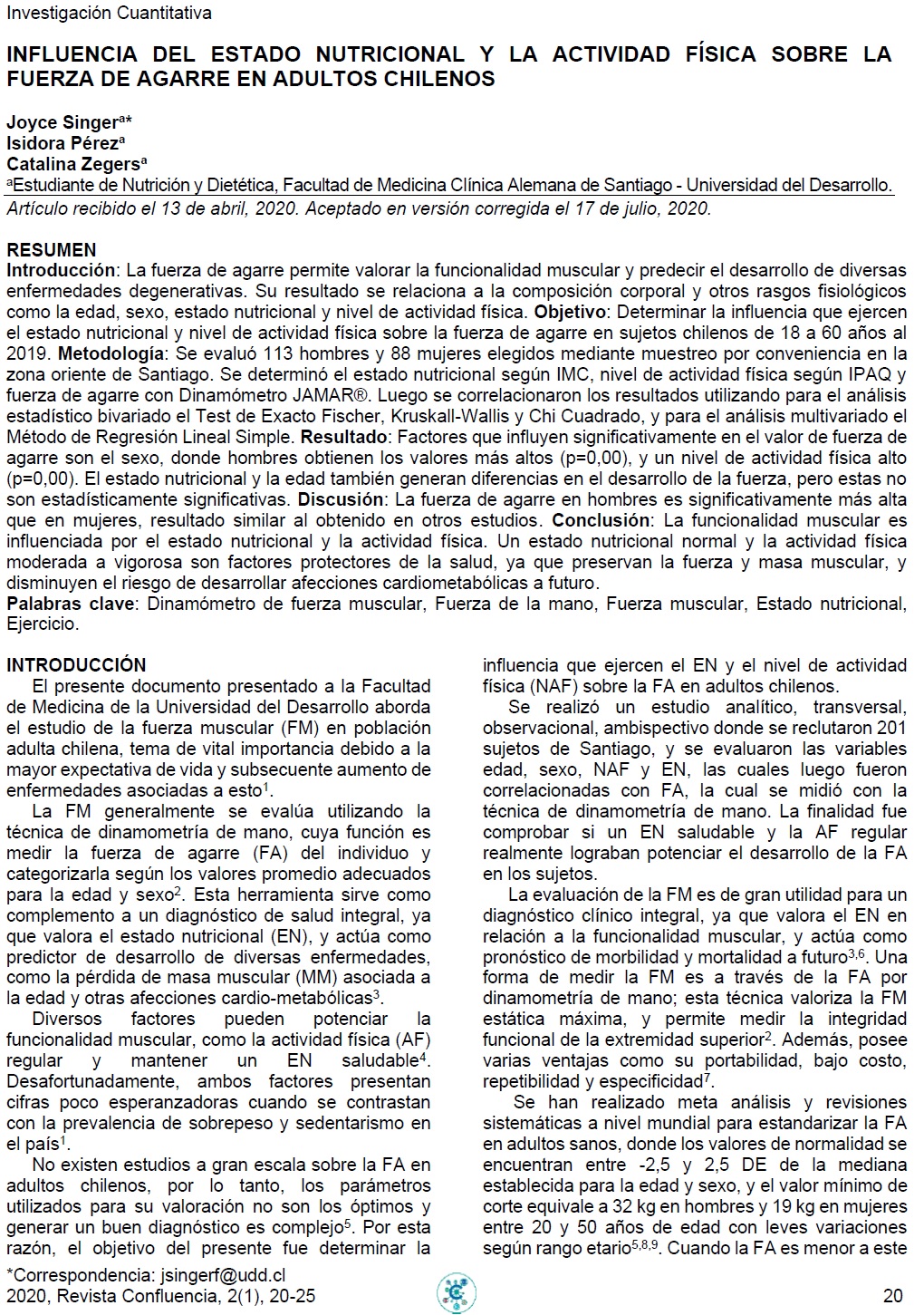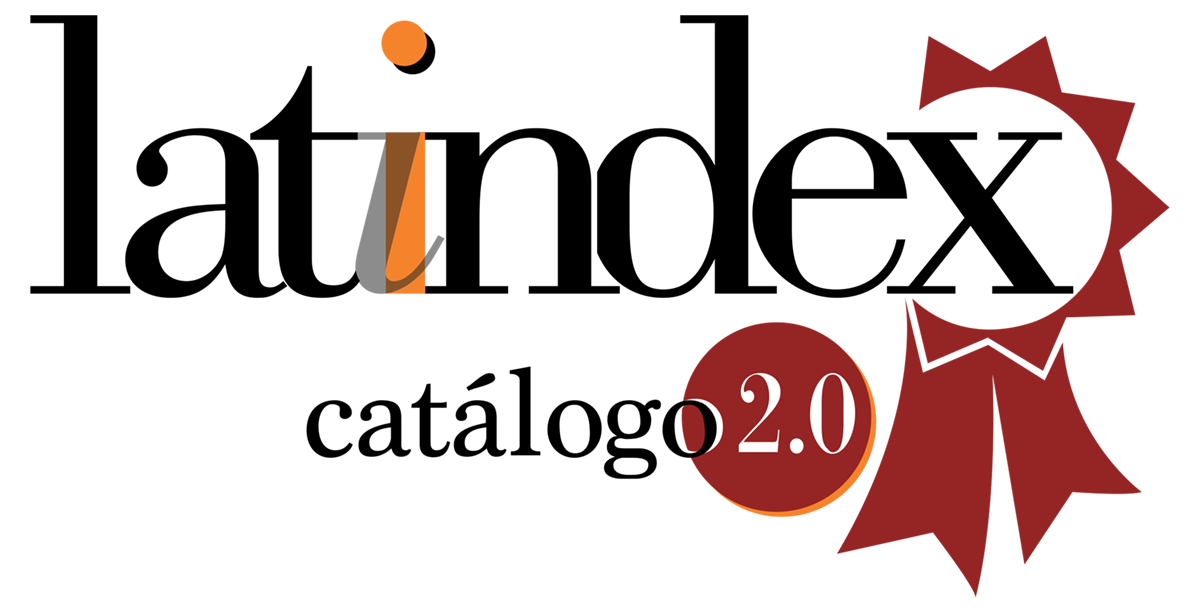Influencia del estado nutricional y la actividad física sobre la fuerza de agarre en adultos chilenos
DOI:
https://doi.org/10.52611/confluencia.num1.2020.495Palabras clave:
Dinamómetro de fuerza muscular, Fuerza de la mano, Fuerza muscular, Estado nutricional, EjercicioResumen
La fuerza de agarre permite valorar la funcionalidad muscular y predecir el desarrollo de diversas enfermedades degenerativas. Objetivo: Determinar la influencia que ejercen el estado nutricional y nivel de actividad física sobre la fuerza de agarre en sujetos chilenos de 18 a 60 años al 2019.Metodología: Se evaluó 113 hombres y 88 mujeres elegidos mediante muestreo por conveniencia en la zona oriente de Santiago. Se determinó el estado nutricional según IMC, nivel de actividad física según IPAQ y fuerza de agarre con Dinamómetro JAMAR®. Luego se correlacionaron los resultados utilizando para el análisis estadístico bivariado el Test de Exacto Fischer, Kruskall-Wallis y Chi Cuadrado,y para el análisis multivariado el Método de Regresión Lineal Simple. Resultado:Factores que influyen significativamente en el valor de fuerza de agarre son el sexo, donde hombres obtienen los valores más altos (p=0,00), y un nivel de actividad física alto (p=0,00). El estado nutricional y la edad también generan diferencias en el desarrollo de la fuerza, pero estas no son estadísticamente significativas. Discusión: La fuerza de agarreen hombres es significativamente más alta que en mujeres, resultado similar al obtenido en otros estudios. Conclusión: La funcionalidad muscular es influenciada por el estado nutricional y la actividad física. Un estado nutricional normal y la actividad física moderada a vigorosa son factores protectores de la salud, ya que preservan la fuerza y masa muscular, y disminuyen el riesgo de desarrollar afecciones cardiometabólicas a futuro.
Descargas
Citas
Ministerio de Salud. Encuesta Nacional de Hábitos de Actividad Física y Deportes en la Población de 18 años y más [Internet]. Santiago: Gobierno de Chile; 2018 [citado el 20 de noviembre de 2019]. Disponible en: http://www.mindep.cl/encuestahabitos/.
Hogrel JY. Grip strength measured by high precision dynamometry in healthy subjects from 5 to 80 years. BMC Musculoskelet Disord. 2015;16:139.
Bohannon RW. Muscle strength: clinical and prognostic value of hand-grip dynamometry. Curr Opin Clin Nutr Metab Care. 2015;18(5):465-70.
Chandrasekaran B, Ghosh A, Prasad C, Krishnan K, Chandrasharma B. Age and anthropometric traits predict handgrip strength in healthy normals. J Hand Microsurg. 2010;2(2):58-61.
Dodds RM, Syddall HE, Cooper R, Kuh D, Cooper C, Sayer AA. Global variation in grip strength: a systematic review and meta-analysis of normative data. Age Ageing. 2016;45(2):209-16.
García JM, García C, Bellido V, Bellido D. A new nutritional approach. Assessment of the patient's nutritional status: function and body composition. Nutr Hosp. 2018;35(0212-1611):1-14.
Chamorro C, Armijo-Olivo S, De la Fuente C, Fuentes J, Chirosa L. Absolute Reliability and Concurrent Validity of Hand Held Dynamometry and Isokinetic Dynamometry in the Hip, Knee and Ankle Joint: Systematic Review and Meta-analysis. Open Med (Wars). 2017;12:359-75.
Dodds RM, Syddall HE, Cooper R, Benzeval M, Deary IJ, Dennison EM, et al. Grip strength across the life course: normative data from twelve British studies. PLoS One. 2014;9(12):e113637.
Sánchez Torralvo FJ, Porras N, Abuín Fernández J, García Torres F, Tapia MJ, Lima F, et al. Normative reference values for hand grip dynamometry in Spain. Association with lean mass. Nutr Hosp. 2018;35(1):98-103.
White JV, Guenter P, Jensen G, Malone A, Schofield M, Group AoNaDMW, et al. Consensus statement of the Academy of Nutrition and Dietetics/American Society for Parenteral and Enteral Nutrition: characteristics recommended for the identification and documentation of adult malnutrition (undernutrition). J Acad Nutr Diet. 2012;112(5):730-8.
Lera L, Albala C, Leyton B, Marquez C, Angel B, Saguez R, et al. Reference values of hand-grip dynamometry and the relationship between low strength and mortality in older Chileans. Clin Interv Aging. 2018;13:317-24.
Kim Y, White T, Wijndaele K, Sharp SJ, Wareham NJ, Brage S. Adiposity and grip strength as long-term predictors of objectively measured physical activity in 93 015 adults: the UK Biobank study. Int J Obes (Lond). 2017;41(9):1361-8.
Füzéki E, Banzer W. Physical Activity Recommendations for Health and Beyond in Currently Inactive Populations. Int J Environ Res Public Health. 2018;15(51042).
Tikkanen P, Nykänen I, Lönnroos E, Sipilä S, Sulkava R, Hartikainen S. Physical activity at age of 20-64 years and mobility and muscle strength in old age: a community-based study. J Gerontol A Biol Sci Med Sci. 2012;67(8):905-10.
Volaklis KA, Halle M, Meisinger C. Muscular strength as a strong predictor of mortality: A narrative review. Eur J Intern Med. 2015;26(5):303-10.
Cruz-Jentoft AJ, Landi F, Schneider SM, Zúñiga C, Arai H, Boirie Y, et al. Prevalence of and interventions for sarcopenia in ageing adults: a systematic review. Report of the International Sarcopenia Initiative (EWGSOP and IWGS). Age Ageing. 2014;43(6):748-59.
Nuttall FQ. Body Mass Index: Obesity, BMI, and Health: A Critical Review. Nutr Today. 2015;50(3):117-28.
Roberts HC, Denison HJ, Martin HJ, Patel HP, Syddall H, Cooper C, et al. A review of the measurement of grip strength in clinical and epidemiological studies: towards a standardised approach. Age Ageing. 2011;40(4):423-9.
Craig CL, Marshall AL, Sjöström M, Bauman AE, Booth ML, Ainsworth BE, et al. International physical activity questionnaire: 12-country reliability and validity. Med Sci Sports Exerc. 2003;35(8):1381-95.
Budziareck MB, Pureza Duarte RR, Barbosa-Silva MC. Reference values and determinants for handgrip strength in healthy subjects. Clin Nutr. 2008;27(3):357-62.
Werle S, Goldhahn J, Drerup S, Simmen BR, Sprott H, Herren DB. Age- and gender-specific normative data of
grip and pinch strength in a healthy adult Swiss population. J Hand Surg Eur Vol. 2009;34(1):76-84.
Haizlip KM, Harrison BC, Leinwand LA. Sex-based differences in skeletal muscle kinetics and fiber-type composition. Physiology (Bethesda). 2015;30(1):30-9.
Miller AE, MacDougall JD, Tarnopolsky MA, Sale DG. Gender differences in strength and muscle fiber characteristics. Eur J Appl Physiol Occup Physiol. 1993;66(3):254-62.
Peters MJ, van Nes SI, Vanhoutte EK, Bakkers M, van Doorn PA, Merkies IS, et al. Revised normative values for grip strength with the Jamar dynamometer. J Peripher Nerv Syst. 2011;16(1):47-50.
Nadeem B, Bacha R, Gilani SA. Correlation of Subcutaneous Fat Measured on Ultrasound with Body Mass Index. J Med Ultrasound. 2018;26(4):205-9.
Liu P, Ma F, Lou H, Liu Y. The utility of fat mass index vs. body mass index and percentage of body fat in the screening of metabolic syndrome. BMC Public Health. 2013;13:629.
Romero-Corral A, Somers VK, Sierra-Johnson J, Thomas RJ, Collazo-Clavell ML, Korinek J, et al. Accuracy of body mass index in diagnosing obesity in the adult general population. Int J Obes (Lond). 2008;32(6):959-66.
Anupi D, Marami D. Correlation between body mass index and handgrip strenght and handgrip endurance among young healthy adults. JEBMH. July 06, 2015;2(27):3995-4001.
Lad UP, Satyanarayana P, Shisode-Lad S, Siri CC, Kumari NR. A Study on the Correlation Between the Body Mass Index (BMI), the Body Fat Percentage, the Handgrip Strength and the Handgrip Endurance in Underweight, Normal Weight and Overweight Adolescents. J Clin Diagn Res. 2013;7(1):51-4.
Van Uffelen JGZ, Khan A, Burton NW. Gender differences in physical activity motivators and context preferences: a population-based study in people in their sixties. BMC Public Health. 2017;17(1):624.
Chacón-Cuberos R, Chacón-Borrego F, Zurita-Ortega F, Cachón-Zagalaz J. Sport profiles by gender and age in adults from Seville. A regression model. Cultura, Ciencia y Deporte. 2016;11(33):207-15.
Pritchard ME, Beaver JL. Do exercise motives predict obligatory exercise? Eat Behav. 2012;13(2):139-41.
Hurley KS, Flippin KJ, Blom LC, Bolin JE, Hoover DL, Judge LW. Practices, Perceived Benefits, and Barriers to Resistance Training Among Women Enrolled in College. Int J Exerc Sci. 2018;11(5):226-38.

Descargas
Publicado
Cómo citar
Número
Sección
Licencia
Derechos de autor 2020 Revista Confluencia

Esta obra está bajo una licencia internacional Creative Commons Atribución-NoComercial-SinDerivadas 4.0.








